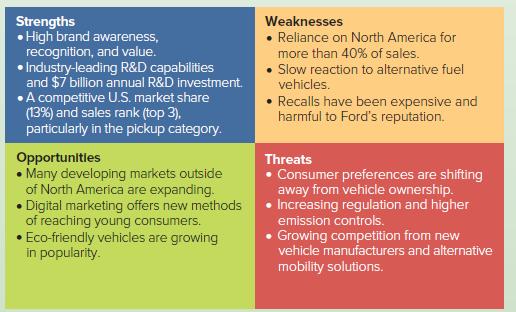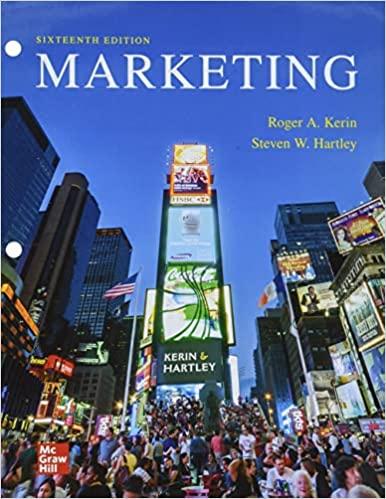Throughout our nearly 118-year history, one thing that has not changed is our desire to help build
Question:
“Throughout our nearly 118-year history, one thing that has not changed is our desire to help build a better world, where every person is free to move and pursue their dreams,” explains Bill Ford, the great-grandson of Henry Ford, and Jim Farley, president and CEO of Ford Motor Company. This purpose is the basis for the company’s strategic marketing process.
THE COMPANY Henry Ford founded the Ford Motor Company in 1903 with an investment of $28,000 from 12 investors. The company quickly introduced and sold 15,000,000 Model Ts, making it one of the best-selling vehicles of all time.
Ford also introduced the assembly line, shorter workdays, higher wages, and a variety of other innovations that transformed transportation, production, and society.
Its innovations led to new cars such as the Thunderbird, the Mustang, the F-150, the Jeep for the U.S. military, and the GT40! As a family company it also introduced a culture of service to its employees and customers.
Today, Ford Motor Company is one of the largest automobile manufacturers in the world. It produces cars, sport utility vehicles, trucks, vans, electric vehicles, hybrids, commercial vehicles, parts, and many other products. Its vehicle brands include Ford and Lincoln.
In addition, the company provides financial services through Ford Motor Credit. The company operates in North America, Europe, Asia, South America, the Middle East, and Africa. Its headquarters are located in Dearborn, Michigan.
The company generates $127 billion in annual sales and has more than 186,000 full-time employees in 34 countries.
To create value, Ford engages in many important business activities.
These include:
• Sustainability-based design.
• Responsible sourcing.
• Efficient logistics.
• Lean manufacturing.
• Customer experience management.
• Vehicle and parts recycling.
The combination of these activities has allowed Ford to create an innovative company adept at responding to the many changes in the current marketplace. As Farley explained when he recently took the CEO position, “I am honored by the opportunity to serve and create value for Ford’s employees, customer, dealers, communities and all of our stakeholders.”
THE STRATEGIC MARKETING PROCESS AT FORD As part of Ford’s planning process it recently unveiled The Plan, its new strategy to drive growth, improve execution, and deliver customer satisfaction. The process includes three phases: planning, implementation, and evaluation.
The Planning Phase. The planning phase begins with a situation analysis (SWOT) for Ford in the current business environment. Figure 1 shows some of the key factors Ford considered in its evaluation. For example, several of Ford’s strengths are the global awareness of its brand, its strong research and development capabilities, and its market leadership in terms of market share.
The company also faces substantial threats as consumer preferences are shifting away from vehicle ownership, there is increasing regulation, and competition from
Fig 1

new types of vehicles is growing. As a result, Ford and Farley have announced that they intend to “transform Ford into a stronger company that can compete and win in the new era of transportation defined by electric, connected and autonomous vehicles.” Subsequent resource allocation decisions assigned $22 billion to the development of battery-powered cars. This decision suggests that Ford is pursuing a differentiation focus strategy.
Ford also evaluated its portfolio and determined that three product lines (pickup trucks, commercial vehicles, and SUVs) were large and profitable. The best-selling vehicle in the United States is the Ford F-150. In fact, Ford sells nearly 900,000 F-150s each year. To protect its market leader position in the pickup category Ford invested in the development of the all-electric F-150 Lightning. The vehicle is positioned to target current pickup truck customers and compete on performance with gas-powered alternatives. As Farley explains, “Play to your strengths, choose your market wisely and execute the product beyond propulsion—that’s the lesson of F-150 Lightning so far.”
Ford also decided to pursue an electric SUV. The company sells approximately 800,000 SUVs each year including the Escape and the Explorer. The category is generally high-priced and profitable, although Ford’s sales and market share have been declining. According to Lisa Teed, brand marketing manager at Ford, “Our original intention was to build a small SUV, a 5-passenger, all new, all electric vehicle. As the team started, what we found is that although they did build one, it wasn’t quite as exciting or dynamic as we expected.
We felt it was missing something.” Consumer research suggested that an electric vehicle like those already on the market just wasn’t desirable.
“So, our next task was to make it desirable,”
says Teed.
The Implementation Phase. As the Ford team worked on the execution of the electric SUV it decided to position the product as a breakthrough vehicle. It needed to be exciting and desirable. These characteristics led the team to think of one of the most successful products in Ford’s history, the Mustang. Teed asked, “Can you build a Mustang and make it electric?” When they decided the answer was yes, the team “understood that this was going to become Mustang Mach-E.” The result was a vehicle with a 300-mile range, 0–60 mph in 3.5 seconds performance, and connected-car technology........

Questions
1. How does Ford’s purpose provide a starting point for its strategic marketing process?
2. What elements of the Ford SWOT analysis support the conclusion that the new era of transportation will be defined by electric, connected, and autonomous vehicles?
3. How did early research and feedback lead Ford from a new SUV to the Mustang Mach-E?
4. Do the initial results of the Mustang Mach-E suggest that the planning process was successful? What marketing and promotional activities would you suggest supporting the introduction?
5. If you were a consultant to Ford Motor Company, what product changes would you recommend increasing future sales?
Step by Step Answer:






